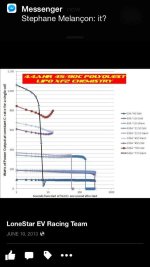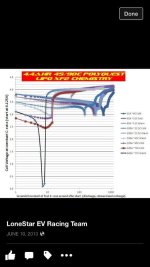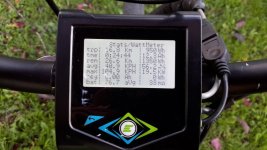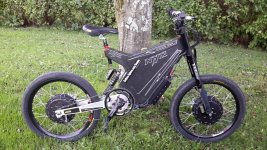I have made a short compilation of most of the tuning settings instruction i am using on the Adaptto:
Here it is step by step:
Note1: you will need to recalibrate above values when when volting up or down on your bike.
Note2: Both manual and auto tuning should be done at the charge state that you are riding in mostly. So don't do it on a fully charged battery nor on a discharged one.
1: Set OVS (fielf weakening) to 0
2: Do a THROTTLE CALIBRATION (thr linear)
3: Lift up the wheel accelerate to 10-15km/h and holding this speed, adjust your ANGLE CORR so you have a smooth rotation.
If the angle is wrong you will hear it and also the wheel will turn more slowly. So keep adjusting it until you have the most silent spin at this speed.
You can also test it on a very long stretch. Find a flat road and drive 15km/h and try and finally keep setting you get the lowest possible temp.
(Angle corr setting compensate for the inaccuracy of the Hall sensors installed. This inaccuracy is the difference between the applied magnetic field of the stator and the Hall sensor angle readings. Since three Hall sensors are installed, this setting is the average deviation of the three gauges from zero. The Deviation of each individual hall sensor is determined and automatically compensated during the motor auto-detect process.)
4: Same goes with IND TIMING. But this time you need to have a constant cruising speed (ex ~35-50km/h). If you do not know what the cruising speed of the motor, then look at"debug" screen, In the line "OA: xxxx DA = xxxx Axxxx" see "Axxxx". Look at the first digit after the letter "A" and gradually speed up motor. It will begin to change in the following order: 8,9, A, B, C, D, E, F. Accordingly, 8 corresponds to the minimum rotation, and F to the maximum. You need a speed corresponding to the letter "D". After reaching motor cruising speed start changing parameter "ind timing". Select a value where the cruising speed is achieved with minimal effort (ie, the minimum throttle). If the wheel does not spin or vice versa spins very quickly, ind timing is off. Very high speed is not valuable. Keep current consumption at no more than 7.5 amps. Under strong throttle, settings above certain values will make the motor begin to slow and get noisy. This should be avoided, reduce the throttle input. Value generally should be slightly less than the threshold at which the motor begins to slow and get noisy.
(Ind timing sets the delay compensation between the signal hall sensor and the control signal of the controller. When rotating at high speeds, the signal from the sensors has been delayed, so you need to adjust the timing. Accordingly, it is the sum of the controller Hall sensor filter circuit delay and the controller CPU processing time. Determined automatically during the motor auto-detect process.)
5. Adjust POWER TIMING so you have maximum torque when you go WOT from 50km/h(about 1/2 of your top speed).(usually values: 0.17 for high-speed motors, 0.3-0.5 for average and 0.7-1.2 for slow motors). PWR timing sets the lead angle shift in relation to the phase current. The greater the inductance of the windings of the motor is, the stronger the control signal phase currents. This setting compensates BEMF.
6: Set OVS timing( field weakening), Optimal values are usually 2-4. OVS timing setting responsible for extra motor speed when the battery voltage is not high enough to achieve the maximum vehicle speed. When the PWM cycle is nearly 100%, the controller increases the lead angle, which enables additional speed (and reduced efficiency of the motor). Only if the voltage is limiting the maximum motor speed, not the wind resistance, will this work.
7: To avoid damage to the controller it is recommended to set the maximum speed limit when configuring profiles somewhere around 20% more than the maximum speed of your vehicle on the road
8: Shunt2 – Power profiles compensation. If the maximum current shown on the ammeter while in use differs from the maximum current set in the power mode profiles, change this value. Adjusting this value will change the settings of current profiles (power mode profiles), while the actual current used does not change. This setting is used to fine tune the displayed current while in use to match the actual controller current limits.
Other important parameters:
Wire R - Stator resistance at standard temperature (24 degrees C). Determined automatically during the motor auto-detect process.
Motor KV - Measured in arbitrary units. Determined automatically during the motor auto-detect process. Wire R and Motor KV values are needed for a new algorithm for calculating the phase current (based on the current speed, control voltage and winding resistance, and not from the control voltage and current, as in the standard version). This algorithm is required to reverse the engine braking, and also improves the smoothness and precision of the phase current limits. It includes the following setting:
Wire R PHC - The use of an alternative algorithm for calculating the phase current. Allows you to calculate the current even at zero cycle of the PWM that is required for proper zero crossing at work reverse braking. Important: when this setting is turned off, the motor KV will be sensed automatically if the motor spins up to medium speed and the throttle is released. After you enable this setting, automatic motor KV sensing does not occur.
Doc





